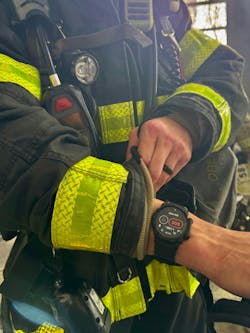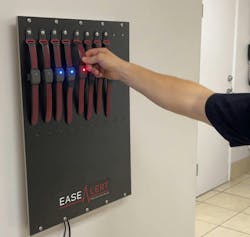The consumer market for wearable technology has grown quickly, from bands and sensors to smartwatches and rings that are designed to provide feedback about the user and augmented reality glasses. After upgrading my smartwatch, I found that the features, reliability and accuracy are vastly improved compared with my previous version.
Then there’s commercial wearable devices. Although not all of these are fire service-ready, at least three have been in development for a long enough period of time that they are being introduced at departments across the country.
3D tracking
Ascent Integrated Tech attracted a lot of attention within the fire service technology space after the company won the 3D Tracking Challenge. The company impressed judges with its multiphase process to expedite the development of tracking technology. Since the competition, the company went to market with an option that uses the Samsung Galaxy Watch7. With Ascent Integrated Tech’s TAK integration, the technology provides location tracking, biometric monitoring and physio alerting, all of which are meant to mitigate risk factors that often lead to firefighter fatalities. The location tracking might not be as precise as the 3D Tracking Challenge results—although above average (generally, corner of the structure and level)—but it’s more operationally relative. It doesn’t require predeployed equipment at an emergency scene nor need to be calibrated, which more-accurate tracking requires. From initial feedback, the company says that there’s a great balance of performance and ease of operational use.
Currently being evaluated in training divisions of some larger departments (e.g., Indianapolis, Milwaukee and Washington, D.C.), the tech seems to provide the best shot at preventing firefighter cardiac-related deaths during or after strenuous activity. Some departments are using the de-identified monitoring: an incident commander (IC) receives biometric monitoring without knowing to whom the device is attached.
Beyond the critical nature of monitoring heart health, biometric tracking also is beneficial in developing tailored exercise programs and sleep coaching and in providing user feedback.
Heart-smart station alerting
As supported by numerous studies and LODD reports, cardiac events consistently are a major cause of firefighter fatalities. Although many factors that are related to the fire service create perfect conditions for a cardiac event, the team at EaseAlert hopes to help to mitigate the stress that’s caused by being awakened by loud station alerting.
As with most wearable devices, the company’s solution is part of a larger system. Backed by a National Institutes of Health-funded clinical study, EaseAlert demonstrated a 169 percent improvement in perceived health when compared with a traditional alerting system.
Although the full system includes LED lights, bed shakers and other installed equipment, it also includes the EaseAlert Wearable (EAW). Resembling a watch, it provides tactile alerting to the wearer whether while sleeping, while completing noisy morning checks with hearing protection in place or while wearing earbuds while in the gym.
The company says that the device also boasts a 21 percent reduction in turnout time and has delivered at least 150,000 alerts faster and safer than a traditional alerting system.
Visual navigation
Qwake Technologies is best known for its C-THRU wearable tech, but like most other wearables, the true power is harnessed by using the entire system.
C-THRU originally was designed for volcanic exploration. A 10-year development process resulted in the creation of 15 new prototypes and field deployment in 80 organizations, including FDNY and numerous smaller volunteer departments. The goal of the placement of the device with organizations is to identify the way that departments use the system and assess for limitations that have yet to be discovered.
The helmet-mounted C-THRU has been shown to improve efficiency of firefighting operations by as much as 300 percent when compared with operations that use a thermal imaging camera (TIC). The augmented reality view has edge detection, an entry-side compass and “breadcrumb navigation.”
The edge detection is an enhancement of TIC views. It helps highlight the edges of objects in zero-visibility conditions.
The compass always points to the side of the structure that the firefighter enters, to help to maintain situational awareness.
Breadcrumb navigation provides a path that users can use to retrace their steps.
All this tech adds to the operational picture for an IC, not to mention expansion plans to create a 3D map.
Although there are no NFPA standards for this type of product, the company follows other applicable standards regarding water, thermal, impact and explosivity protections. The company built an application programming interface (API) to allow any vendor to build a connection.
Champions and challenges
Although each of the aforementioned vendors is charting its way into unfamiliar territory, all of them described the tribulations of gaining traction in a field that sometimes struggles to embrace new technology. Whether resistance is grounded in tradition, a fear of “big brother” having access to biometric data or departments wanting to avoid an overreliance on technology, fire service tech companies have a steeper hill to climb to reach adoption status than other tech industries. That said, the stories of how these companies came
into existence are encouraging, because each has champions who are early
adopters and testers.
An argument that times are changing can be found when you realize that Qwake Technologies had more than 400 applicant organizations for its initial deployment.
All three companies challenge the idea that innovation in the fire service doesn’t exist. Sam Cossman, who is CEO and co-founder of Qwake Technologies, says he was told that firefighters aren’t ready/aren’t innovative enough for his company’s tech. When asked how department leadership can help to encourage positive participation in any wearable technology initiative, the commonality was to have an opt-in/opt-out policy. Not everyone is willing to try innovative technology; sometimes it’s better to have partial adoption rather than forced adoption or no adoption at all.
Another forward-thinking concept includes putting policy limitations and expectations on what biometric data can and can’t be used for, to alleviate apprehensions or to set transparent parameters for intended use.
If truly embraced, emerging technologies, particularly in the wearable tech space, have enormous potential to reduce certain types of firefighter fatalities. The culture of continuing to do things “the way that it always has been done” must change. Using tech to complete searches faster isn’t just about being good at performing on the job; it also gives victims a better chance of survival and reduces members’ exposure to hazardous products of combustion. Using tech to ensure that members don’t overexert themselves isn’t about taking away the fun of the job but, rather, taking away the pain and heartache of the loss of a firefighter in the line of duty.
How to get involved
If you’re a fire service leader, it’s time to consider the cost/benefit of emerging tech and to know that early adopters often get a chance to help to steer development. Compared with even 10 years ago, there are so many start-ups and people who have ideas to help to solve real-world problems.
If you’re riding the tailboard, you can help by going to conferences and trade shows. Not every solution that you encounter will work in your department; however, many products might be exactly what you need to solve an issue that your department is experiencing.
There always are considerations regarding budget and liability, but any department that genuinely wants to be innovative will have leaders who know how to get their crews the best tools and equipment to get the job done.
About the Author

Jason Moore
Jason Moore is a 23-year veteran of the fire service who began his career with the U.S. Air Force as a fire protection specialist. Moore is involved with the International Association of Fire Chiefs’ Technology Council and is a founding member/associate director of the Indiana University Crisis Technologies Innovation Lab. He delivered presentations on implementing technology, using technology for community risk reduction and best practices to justify funding for innovative programs. Moore was the keynote speaker at FireFusion 2024.

